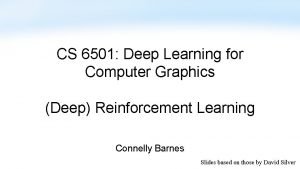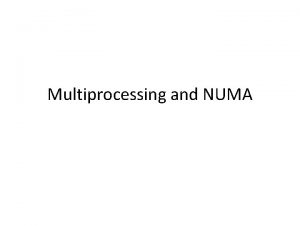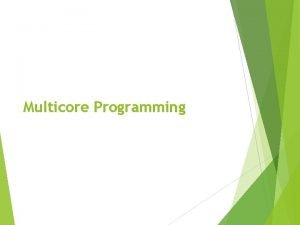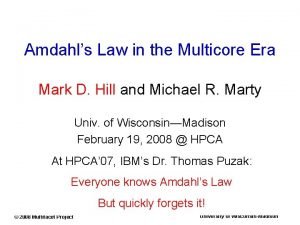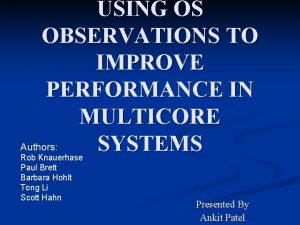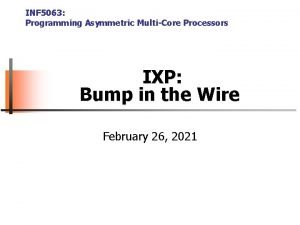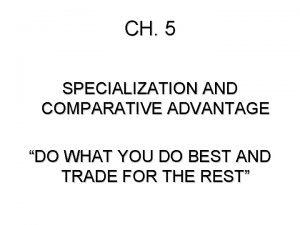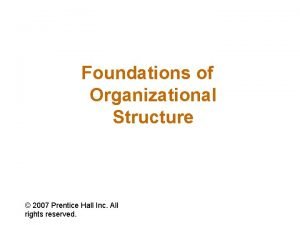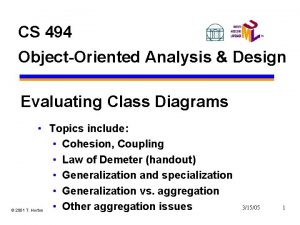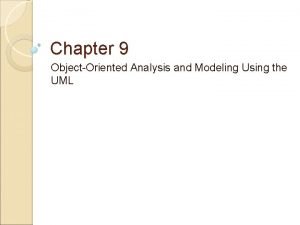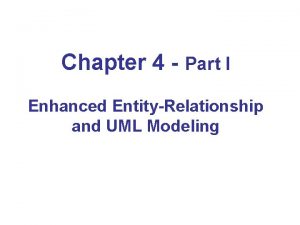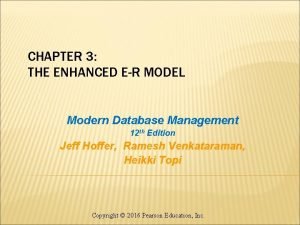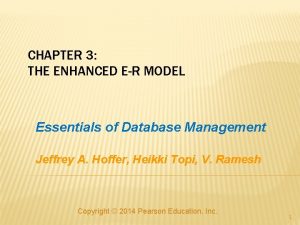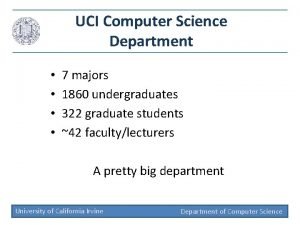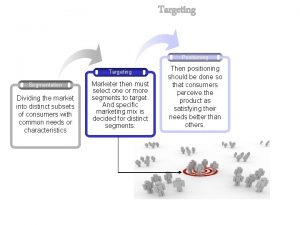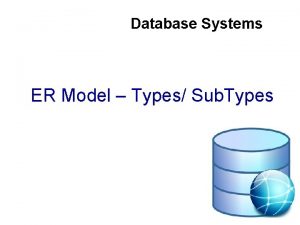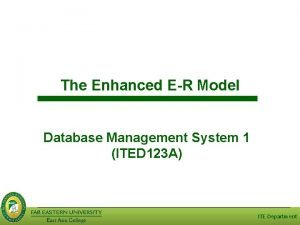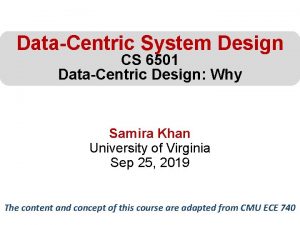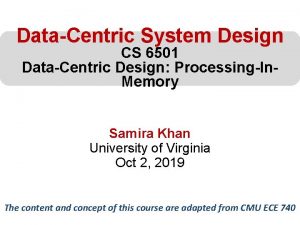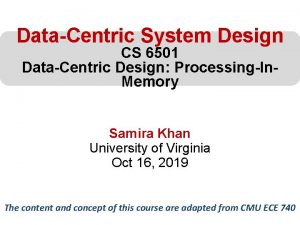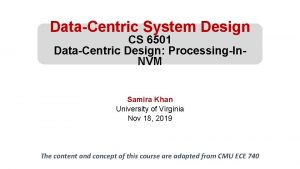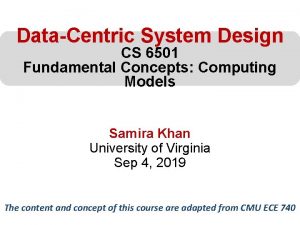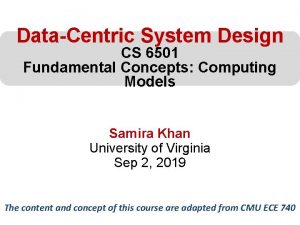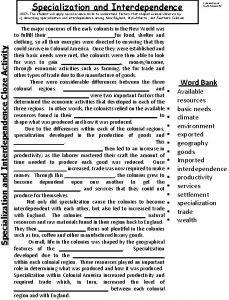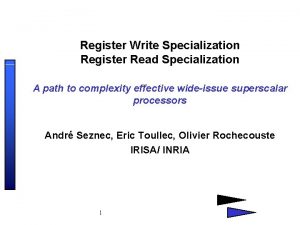DataCentric System Design CS 6501 MultiCore and Specialization


















































- Slides: 50

Data-Centric System Design CS 6501 Multi-Core and Specialization Samira Khan University of Virginia Sep 23, 2019 The content and concept of this course are adapted from CMU ECE 740

AGENDA • Logistics • Review from last lecture • Multi-Core and Specialization • Data-Centric Design 2

LOGICTICS • Reviews Due Sep 26, 2019 • Esmaeilzadeh et al. , "Dark silicon and the end of multicore scaling", ISCA 2011. • Jouppi et al. , "In-Datacenter Performance Analysis of a Tensor Processing Unit", ISCA 2017. 3

LOGICTICS • Project Proposal • Proposal presentations: Oct 9, 2019 • Please discuss the project with the instructors • Sample proposals on Piazza 4

MULTI-CORE VS. LARGE SUPERSCALAR • Multi-core advantages + Simpler cores more power efficient, lower complexity, easier to design and replicate, higher frequency (shorter wires, smaller structures) + Higher system throughput on multiprogrammed workloads reduced context switches + Higher system throughput in parallel applications • Multi-core disadvantages - Requires parallel tasks/threads to improve performance (parallel programming) - Resource sharing can reduce single-thread performance - Shared hardware resources need to be managed - Number of pins limits data supply for increased demand 5

THE PROBLEM: SERIALIZED CODE SECTIONS • Many parallel programs cannot be parallelized completely • Causes of serialized code sections – Sequential portions (Amdahl’s “serial part”) – Critical sections – Barriers • Serialized code sections – Reduce performance – Limit scalability – Waste energy 6

EXAMPLE FROM MYSQL ? ? ? Critical Section Access Open Tables Cache 8 7 Speedup Open database tables 6 5 4 3 2 Perform the operations …. Today 1 Parallel 0 0 8 16 24 32 Chip Area (cores) 7

Demands in Different Code Sections • What we want: • In a serialized code section one powerful “large” core • In a parallel code section many wimpy “small” cores • These two conflict with each other: – If you have a single powerful core, you cannot have many cores – A small core is much more energy and area efficient than a large core 8

“LARGE” VS. “SMALL” CORES Large Core • • Out-of-order Wide fetch e. g. 4 -wide Deeper pipeline Aggressive branch predictor (e. g. hybrid) • Multiple functional units • Trace cache • Memory dependence speculation Small Core • • In-order Narrow Fetch e. g. 2 -wide Shallow pipeline Simple branch predictor (e. g. Gshare) • Few functional units Large Cores are power inefficient: e. g. , 2 x performance for 4 x area (power) 9

REMEMBER THE DEMANDS • What we want: • In a serialized code section one powerful “large” core • In a parallel code section many wimpy “small” cores • These two conflict with each other: – If you have a single powerful core, you cannot have many cores – A small core is much more energy and area efficient than a large core • Can we get the best of both worlds? 10

CAN WE GET THE BEST OF BOTH WORLDS? • Tile Large + High performance on single thread, serial code sections (2 units) - Low throughput on parallel program portions (8 units) • Tile Small + High throughput on the parallel part (16 units) - Low performance on the serial part, single thread (1 unit), reduced single-thread performance compared to existing single thread processors • Idea: Have both large and small on the same chip Performance asymmetry 11

ASYMMETRIC MULTI-CORE

Asymmetric Chip Multiprocessor (ACMP) Large core “Tile-Large” Small core Small core Small core Small core Small core “Tile-Small” Small core Small core Small core Large core ACMP • Provide one large core and many small cores + Accelerate serial part using the large core (2 units) + Execute parallel part on small cores and large core for high throughput (12+2 units) 13

ACCELERATING SERIAL BOTTLENECKS Single thread Large core Small core Small core Small core ACMP Approach 14

PERFORMANCE VS. PARALLELISM Assumptions: 1. Small cores takes an area budget of 1 and has performance of 1 2. Large core takes an area budget of 4 and has performance of 2 15

ACMP PERFORMANCE VS. PARALLELISM Area-budget = 16 small cores Large core Small Small core core Large core “Tile-Large” Large core Small core core Small Small Small Small core core core “Tile-Small” ACMP Large Cores 4 0 1 Small Cores 0 16 12 Serial Performance 2 1 2 2 x 4=8 1 x 16 = 16 1 x 2 + 1 x 12 = 14 Parallel Throughput 16 16

ACCELERATING PARALLEL BOTTLENECKS • Serialized or imbalanced execution in the parallel portion can also benefit from a large core • Examples: – Critical sections that are contended – Parallel stages that take longer than others to execute • Idea: Dynamically identify these code portions that cause serialization and execute them on a large core 17

CONTENTION FOR CRITICAL SECTIONS Critical Section 12 iterations, 33% instructions inside the critical section Parallel Idle P=4 P=3 P=2 33% in critical section P=1 0 1 2 3 4 5 6 7 8 9 10 11 12 18

CONTENTION FOR CRITICAL SECTIONS Critical Section 12 iterations, 33% instructions inside the critical section Parallel Idle P=4 Accelerating critical sections increases performance and scalability P=3 Critical Section Accelerated by 2 x P=2 P=1 0 1 2 3 4 5 6 7 8 9 10 11 12 19

IMPACT OF CRITICAL SECTIONS ON SCALABILITY • Contention for critical sections leads to serial execution (serialization) of threads in the parallel program portion • Contention for critical sections increases with the number of threads and limits scalability 8 Asymmetric Speedup 7 6 5 4 3 2 Today 1 0 0 8 16 24 32 Chip Area (cores) My. SQL (oltp-1) 20

A CASE FOR ASYMMETRY • Execution time of sequential kernels, critical sections, and limiter stages must be short • It is difficult for the programmer to shorten these serialized sections – Insufficient domain-specific knowledge – Variation in hardware platforms – Limited resources • Goal: A mechanism to shorten serial bottlenecks without requiring programmer effort • Idea: Accelerate serialized code sections by shipping them to powerful cores in an asymmetric multi-core (ACMP) 21

AN EXAMPLE: ACCELERATED CRITICAL SECTIONS • Idea: HW/SW ships critical sections to a large, powerful core in an asymmetric multi-core architecture • Benefit: – Reduces serialization due to contended locks – Reduces the performance impact of hard-to-parallelize sections – Programmer does not need to (heavily) optimize parallel code fewer bugs, improved productivity • Suleman et al. , “Accelerating Critical Section Execution with Asymmetric Multi. Core Architectures, ” ASPLOS 2009, IEEE Micro Top Picks 2010. • Suleman et al. , “Data Marshaling for Multi-Core Architectures, ” ISCA 2010, IEEE Micro Top Picks 2011. 22

ACCELERATED CRITICAL SECTIONS Enter. CS() Priority. Q. insert(…) Leave. CS() 1. P 2 encounters a critical section (CSCALL) 2. P 2 sends CSCALL Request to CSRB 3. P 1 executes Critical Section 4. P 1 sends CSDONE signal Core executing critical section P 1 P 2 Critical Section Request Buffer (CSRB) P 3 P 4 Onchip. Interconnect 23

ACCELERATED CRITICAL SECTIONS (ACS) Small Core A = compute() PUSH A CSCALL X, Target PC LOCK X result = CS(A) UNLOCK X print result … … … … Large Core CSCALL Request Send X, TPC, STACK_PTR, CORE_ID … Waiting in Critical Section Request … Buffer (CSRB) … TPC: Acquire X POP A result = CS(A) PUSH result Release X CSRET X CSDONE Response POP result print result Suleman et al. , “Accelerating Critical Section Execution with Asymmetric Multi. Core Architectures, ” ASPLOS 2009. 24

ACS PERFORMANCE TRADEOFFS n Pluses + Faster critical section execution + Shared locks stay in one place: better lock locality + Shared data stays in large core’s (large) caches: better shared data locality, less ping-ponging n Minuses - Large core dedicated for critical sections: reduced parallel throughput - CSCALL and CSDONE control transfer overhead - Thread-private data needs to be transferred to large core: worse private data locality 25

ACS PERFORMANCE TRADEOFFS • Fewer parallel threads vs. accelerated critical sections – Accelerating critical sections offsets loss in throughput – As the number of cores (threads) on chip increase: • Fractional loss in parallel performance decreases • Increased contention for critical sections makes acceleration more beneficial • Overhead of CSCALL/CSDONE vs. better lock locality – ACS avoids “ping-ponging” of locks among caches by keeping them at the large core • More cache misses for private data vs. fewer misses for shared data 26

CACHE MISSES FOR PRIVATE DATA Priority. Heap. insert (New. Sub. Problems) Private Data: New. Sub. Problems Shared Data: The priority heap Puzzle Benchmark 27

ACS PERFORMANCE TRADEOFFS • Fewer parallel threads vs. accelerated critical sections – Accelerating critical sections offsets loss in throughput – As the number of cores (threads) on chip increase: • Fractional loss in parallel performance decreases • Increased contention for critical sections makes acceleration more beneficial • Overhead of CSCALL/CSDONE vs. better lock locality – ACS avoids “ping-ponging” of locks among caches by keeping them at the large core • More cache misses for private data vs. fewer misses for shared data – Cache misses reduce if shared data > private data This problem can be solved 28

ACS COMPARISON POINTS Small core Small core Small core Small core Small core Small core Small core Small core Large core n n Conventional locking Large core executes Amdahl’s serial part Small core Small core Small core Large core ACMP SCMP • Conventional locking Small core ACS n Large core executes Amdahl’s serial part and critical sections 29

ACCELERATED CRITICAL SECTIONS: METHODOLOGY n Workloads: 12 critical section intensive applications q Data mining kernels, sorting, database, web, networking n Multi-core x 86 simulator q 1 large and 28 small cores q Aggressive stream prefetcher employed at each core n Details: q Large core: 2 GHz, out-of-order, 128 -entry ROB, 4 -wide, 12 -stage q Small core: 2 GHz, in-order, 2 -wide, 5 -stage q Private 32 KB L 1, private 256 KB L 2, 8 MB shared L 3 q On-chip interconnect: Bi-directional ring, 5 -cycle hop latency 30

ACS PERFORMANCE Chip Area = 32 small cores Equal-area comparison Number of threads = Best threads SCMP = 32 small cores ACMP = 1 large and 28 small cores 269 180 185 Coarse-grain locks Fine-grain locks 31

EQUAL-AREA COMPARISONS ------ SCMP ------ ACS Number of threads = No. of cores Speedup over a small core 3, 5 3 2, 5 2 1, 5 1 0, 5 0 3 5 2, 5 4 2 3 1, 5 2 1 0, 5 1 0 0 0 8 16 24 32 (a) ep (b) is 6 10 5 8 4 2 1 2 0 0 0 8 16 24 32 (c) pagemine (d) puzzle 6 4 4 2 0 0 8 16 24 32 (g) sqlite (h) iplookup 3, 5 3 2, 5 2 1, 5 1 0, 5 0 0 8 16 24 32 8 6 3 7 6 5 4 3 2 1 0 0 8 16 24 32 (i) oltp-1 14 12 10 8 6 4 2 0 0 8 16 24 32 (e) qsort (f) tsp 12 3 12 10 2, 5 10 8 2 8 6 1, 5 6 4 1 4 2 0, 5 2 0 0 8 16 24 32 (i) oltp-2 0 8 16 24 32 (k) specjbb 0 8 16 24 32 (l) webcache Chip Area (small cores) 32

ACS SUMMARY • Critical sections reduce performance and limit scalability • Accelerate critical sections by executing them on a powerful core • ACS reduces average execution time by: – 34% compared to an equal-area SCMP – 23% compared to an equal-area ACMP • ACS improves scalability of 7 of the 12 workloads • Generalizing the idea: Accelerate all bottlenecks (“critical paths”) by executing them on a powerful core 33

Multicore Decade? We have relied on multicore scaling for over five years. ? 2000 2005 Pentium Core 2 Extreme Quad-Core Dual-Core 2010 i 7 980 x Hex-Core 2015 How much longer will it be our primary performance scaling technique? 34

Finding Optimal Multicore Designs Comprehensive design space: – – – Fixed area budget Fixed power budget Two sets of CMOS scaling projections Optimal core and diverse multicore organizations Parallel benchmarks For next 5 technology generations, find the best performing multicore from a comprehensive design space search for each of the PARSEC benchmarks 35

Symmetric Multicore Projections 20 16 18 x Target Speedup Symmetric 12 8 3. 4 x in 10 years 4 0 0 2 4 Year 6 8 10 Symmetric multicores alone will not sustain the multicore era. 36

Multicore Solutions 20 Asymmetric Topologies Target Symmetric 16 Speedup Asymmetric 12 8 3. 5 x 4 0 0 2 4 Year 6 8 10 37

Multicore Solutions 20 Dynamic Topologies Target Symmetric 16 Speedup Asymmetric 12 Dynamic 8 3. 5 x 4 0 0 2 4 Year 6 8 10 [Chakraborty (2008), Suleman et al (2009)] 38

Multicore Solutions Speedup 20 Composed/Fused Topologies Target 16 Symmetric Asymmetric 12 Dynamic Composed 8 3. 7 x 4 0 0 2 4 Year 6 8 10 [Ipek et al (2007), Kim et al (2007)] 39

Multicore Solutions 20 Target Symmetric 16 Speedup Asymmetric Dynamic 12 Composed 8 GPU 2. 7 x 4 0 0 2 4 Year 6 8 10 40

Multicore Era Projections 20 16 18 x Target Speedup Composed 12 8 4 0 3. 7 x 0 2 4 Year 6 8 The best designs speed up 14% per year rather than the recent trend of 34% per year 10 41

WITH MULTIPLE CORES ON CHIP • What we want: – N times the performance with N times the cores when we parallelize an application on N cores • What we get: – Amdahl’s Law (serial bottleneck) – Bottlenecks in the parallel portion 42

CAVEATS OF PARALLELISM • Amdahl’s Law – f: Parallelizable fraction of a program – N: Number of processors 1 Speedup = 1 -f – + f N Amdahl, “Validity of the single processor approach to achieving large scale computing capabilities , ” AFIPS 1967. • Maximum speedup limited by serial portion: Serial bottleneck • Parallel portion is usually not perfectly parallel – Synchronization overhead (e. g. , updates to shared data) – Load imbalance overhead (imperfect parallelization) – Resource sharing overhead (contention among N processors) 43

THE PROBLEM: SERIALIZED CODE SECTIONS • Many parallel programs cannot be parallelized completely • Causes of serialized code sections – Sequential portions (Amdahl’s “serial part”) – Critical sections – Barriers • Serialized code sections – Reduce performance – Limit scalability – Waste energy 44

Why Diminishing Returns? • Transistor area is still scaling • Voltage and capacitance scaling have slowed • Result: designs are power, not area, limited 45

Dark Silicon Percentage Dark Silicon 100% nm: At. At 228 nm: ITRS Conservative 80% 71% 60% 51% 40% Sources of Dark Silicon: Power + Limited Parallelism 20% 0% blacksholes bodytrack canneal ferret streamcluster 17% 26% GM GM 46

Conclusions Multicore performance gains are limited Unicore Era Multicore Era ? Need at least 18%-40% per generation from architecture alone without additional power 47

Specialization Innovation Efficiency 48

Can Specialization solve the problem? 49

Data-Centric System Design CS 6501 Multi-Core and Specialization Samira Khan University of Virginia Sep 22, 2019 The content and concept of this course are adapted from CMU ECE 740
 6501 in word
6501 in word Coen 6501
Coen 6501 Cs 6501
Cs 6501 Cs 6501
Cs 6501 Cs 6501
Cs 6501 Multiprocessor and multicore
Multiprocessor and multicore Speedy transactions in multicore in-memory databases
Speedy transactions in multicore in-memory databases Multicore packet scheduler samsung
Multicore packet scheduler samsung Multicore programming
Multicore programming And eat
And eat Cache craftiness for fast multicore key-value storage
Cache craftiness for fast multicore key-value storage Pcie-1429
Pcie-1429 Obs multicore
Obs multicore Asymmetric multicore processing
Asymmetric multicore processing Autosar multicore
Autosar multicore Define output design
Define output design Unit 8
Unit 8 Comparative advantage exists when one person can produce
Comparative advantage exists when one person can produce Roman empire specialization
Roman empire specialization Specialization and interdependence
Specialization and interdependence Specialization and interdependence
Specialization and interdependence Specialization and exchange
Specialization and exchange Division of labour disadvantages
Division of labour disadvantages Specialization and comparative advantage
Specialization and comparative advantage Economies and diseconomies of work specialization
Economies and diseconomies of work specialization Generalization and specialization in java
Generalization and specialization in java User interface design in system analysis and design
User interface design in system analysis and design Dialogue design
Dialogue design What was specialization
What was specialization Contoh supertype dan subtype
Contoh supertype dan subtype Work specialization
Work specialization How might specialization encourage trade?
How might specialization encourage trade? Partial specialization rule adalah
Partial specialization rule adalah Specialization economics
Specialization economics Supervisor supervisee
Supervisor supervisee Uml specialization
Uml specialization Uml specialization
Uml specialization Total specialization rule
Total specialization rule Disjoint rule example
Disjoint rule example Specialization economics
Specialization economics Cs 163 uci
Cs 163 uci Partial specialization rule example
Partial specialization rule example Yestoapps.com
Yestoapps.com Selective specialization example
Selective specialization example Product sales structure
Product sales structure Infusion specialization
Infusion specialization Supertype and subtype entities
Supertype and subtype entities Specialization vs differentiation
Specialization vs differentiation Advantages of specialization
Advantages of specialization Maya social structure
Maya social structure Database specialization
Database specialization




